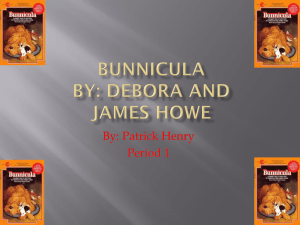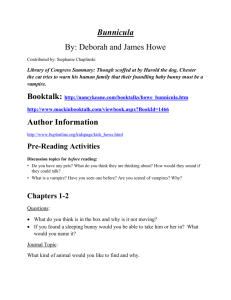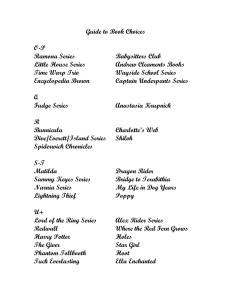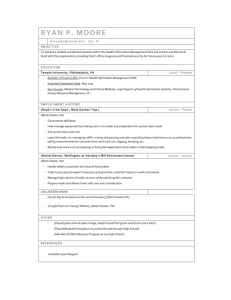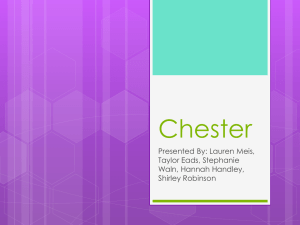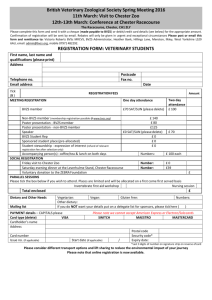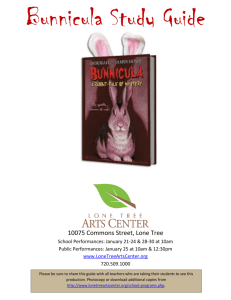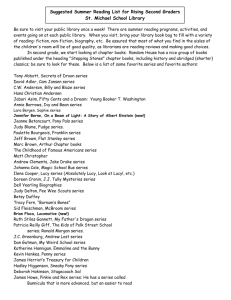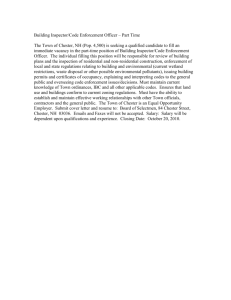Bunnicula Study Guide - Weidner Center for the Performing Arts
advertisement
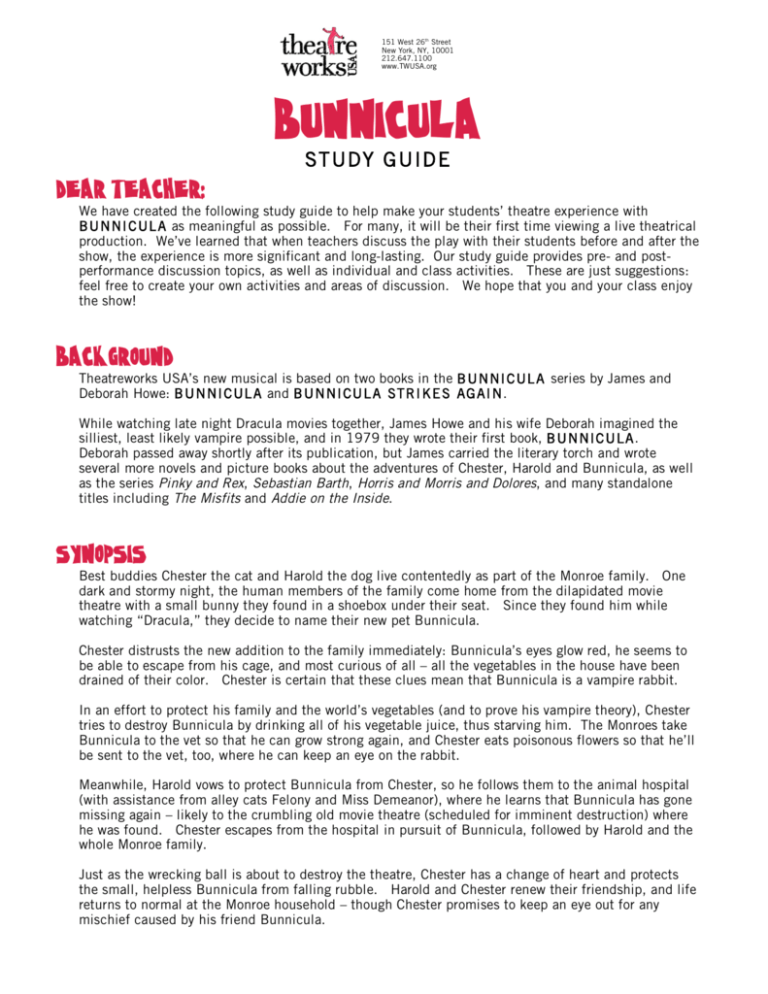
! 151 West 26th Street New York, NY, 10001 212.647.1100 www.TWUSA.org BUNNICULA ! STUDY G UID E DEAR TEACHER: We have created the following study guide to help make your students’ theatre experience with BU N NI C UL A as meaningful as possible. For many, it will be their first time viewing a live theatrical production. We’ve learned that when teachers discuss the play with their students before and after the show, the experience is more significant and long-lasting. Our study guide provides pre- and postperformance discussion topics, as well as individual and class activities. These are just suggestions: feel free to create your own activities and areas of discussion. We hope that you and your class enjoy the show! BACKGROUND Theatreworks USA’s new musical is based on two books in the B U N NI C UL A series by James and Deborah Howe: B U N NI C UL A and B U N NI CU L A STRI KE S AG AI N. While watching late night Dracula movies together, James Howe and his wife Deborah imagined the silliest, least likely vampire possible, and in 1979 they wrote their first book, B U N NIC U LA. Deborah passed away shortly after its publication, but James carried the literary torch and wrote several more novels and picture books about the adventures of Chester, Harold and Bunnicula, as well as the series Pinky and Rex, Sebastian Barth, Horris and Morris and Dolores, and many standalone titles including The Misfits and Addie on the Inside. SYNOPSIS Best buddies Chester the cat and Harold the dog live contentedly as part of the Monroe family. One dark and stormy night, the human members of the family come home from the dilapidated movie theatre with a small bunny they found in a shoebox under their seat. Since they found him while watching “Dracula,” they decide to name their new pet Bunnicula. Chester distrusts the new addition to the family immediately: Bunnicula’s eyes glow red, he seems to be able to escape from his cage, and most curious of all – all the vegetables in the house have been drained of their color. Chester is certain that these clues mean that Bunnicula is a vampire rabbit. In an effort to protect his family and the world’s vegetables (and to prove his vampire theory), Chester tries to destroy Bunnicula by drinking all of his vegetable juice, thus starving him. The Monroes take Bunnicula to the vet so that he can grow strong again, and Chester eats poisonous flowers so that he’ll be sent to the vet, too, where he can keep an eye on the rabbit. Meanwhile, Harold vows to protect Bunnicula from Chester, so he follows them to the animal hospital (with assistance from alley cats Felony and Miss Demeanor), where he learns that Bunnicula has gone missing again – likely to the crumbling old movie theatre (scheduled for imminent destruction) where he was found. Chester escapes from the hospital in pursuit of Bunnicula, followed by Harold and the whole Monroe family. Just as the wrecking ball is about to destroy the theatre, Chester has a change of heart and protects the small, helpless Bunnicula from falling rubble. Harold and Chester renew their friendship, and life returns to normal at the Monroe household – though Chester promises to keep an eye out for any mischief caused by his friend Bunnicula. THE CAST OF CHARACTERS: HUMANS: Mom: a lawyer Dad: a college professor Debbie: the elder Monroe child Toby: the younger Monroe child Dr. Greenbriar: the veterinary doctor ANIMALS: Harold: the family dog, and the narrator of our story Chester: a suspicious cat, utterly protective of his family Bunnicula: a rabbit that may or may not be a vampire Felony and Miss Demeanor: a couple of streetwise alley cats Pitbull: a tough-talking dog at the animal hospital Parrot: a cackling old bird in need of behavioral modification Kitty: a nervous young cat convinced that she’s at the vet by mistake BEFORE SEEING THE SHOW: There are a number of vocabulary words and cultural references in B U N NI C UL A that may be unfamiliar to your students. Review the following with them so that can fully enjoy the production. VOCABULARY • Albino: an animal or plant with a marked deficiency in pigmentation • Anemic: lacking power or vitality • (go) Ballistic: to become overwrought or irrational (informal) • Contamination: the state of being impure by contact with something unclean • Crevices: cracks forming an opening • Depraved: corrupt or wicked • Felony: a crime of graver character than those called misdemeanors • Grotesque: odd or unnatural in shape, appearance, or character • Haunches: the hindquarters of an animal • Lox: a salt cured salmon, often eaten with cream cheese on a bagel • Misdemeanor: an instance of misbehavior • Parasite: a person who receives support from another without giving any useful return • Wrath: strong anger LITERARY/CULTURAL REFERENCES: • Van Helsing (Chester compares himself to this character in Bram Stoker’s “Dracula” – a legendary vampire hunter) • “It is a far, far better thing that I do, than I have ever done; it is a far, far better rest that I go to than I have ever known.” (from Charles Dickens’ “A Tale of Two Cities” – protagonist Sydney Carlton’s unspoken thoughts while ascending to the guillotine in an unjust conviction) • “Give me liberty, or give me death” (a quotation attributed Patrick Henry from a speech he made in 1775 supporting the deployment of Virginia troops to fight the Revolutionary War) LEARNING ABOUT THEATRE Discuss with your students: 1. Some • • • • • • important terms to know about a musical Setting (where and when does the story take place?) Characters (who are the people – and animals?) Plot (what happens?) Theme (what is the Big Idea?) Structure: Acts and Scenes (how is the play “built”) Style (how again: realistic? Fantastical? Futuristic? – etc.) 2. Some • • • • important people who make a musical happen: Good playwright, composer, and lyricist Creative director and choreographer Believable actors Imaginative designers: • Set • Costumes • Lighting • Sound • Props 3. Great audiences can make good shows even better. Here’s how: • Listen, really listen! • Laugh if it’s funny, cry if it’s sad – but please don’t talk (actors hear you, and so do your fellow audience members) • Exercise your memory (Hey! That’s the movie theatre they talked about in the first scene!) • Turn off your cell phones, ipods, and hand-held video games! No photos! • Eat your candy bar before or after the show. It is impossible to unwrap it quietly! 4. Learning about Life (Issues to think about and discuss in small groups or as a class) Much of this musical’s story is about overcoming prejudices based on others’ physical appearance or personal habits, and jumping to wild conclusions on the basis of incomplete evidence. In B UN NI C UL A, disagreements about these ideas lead to a rift in friendship between best friends Harold and Chester. Explore, write about, and perhaps share your experiences in this regard: • Have you ever been fooled by appearance? Have your preconceived notions been proven incorrect – while trying strange-looking food, riding scary-looking amusement park rides, or even while making assumptions about people based on the way they look or act? • What is prejudice? How is prejudice different from not liking someone? Have your students ever experienced prejudice? In what way? How did it make them feel? • Have your students every gotten into an argument with a sibling or friend? How did that make them feel? Were they able to repair the relationship? How? AFTER SEEING THE MUSICAL 1. Being Drama Critics: While it’s still fresh in your minds, discuss: • If your students read the Bunnicula books prior to seeing the show, talk about differences and similarities between the books and the musical. Did the changes add to or detract from the story? Why or why not? • Discuss the main characters, and the actors who portrayed them. What specific lines or actions did the actors use to help you understand these characters as individuals? If you were directing the musical, would you change or add anything about the characters? • How did the musical numbers change or add to your understanding of the characters and the story? Which songs and dances did you particularly enjoy, and why? • Discuss the designs. How did the cartoony sets enhance the tone of the show? How did the costumes say something about the characters – especially the animals? 2. Thinking about Tolerance Chester is initially suspicious of Bunnicula, and soon tries to destroy the rabbit in order to protect the family. Eventually, though, Chester learns to appreciate Bunnicula’s odd habits and sings “Strange creatures change into new friends if you let them… It could be true that the monster you fear and you aren’t really all that different.” Even though they are very different, Chester overcomes his prejudice of Bunnicula’s vampire-like traits, and learns to accept him for who he is. Consider some of the ways that we are different from each other – gender, cultural background, handicapped or not, height, eye color, etc. Discuss in small groups or as a class about how we are all the same on the inside and how everyone deserves respect and to be treated fairly, despite our differences. ADDITIONAL ACTIVITIES 1. Deductive Reasoning What clues led Chester to believe that Bunnicula was a vampire? (For the teacher’s reference, these include: Red eyes, the presence of fangs, cape-like markings on its back, nocturnal habits, vegetables drained of their color, etc.) Chester used deductive reasoning to come up with his conclusion. A simple way to demonstrate the concepts of deductive reasoning – asking questions from the general to the specific – is by playing 20 Questions with your class. Begin by asking a question (ie: “What animal am I thinking of”), and solicit questions from your students that can be answered “yes” or “no” (for example: Does the animal live on a farm? Does the animal eat meat? Is the animal bigger than a loaf of bread?). Your students will learn how to winnow a world of possibilities down to one answer. A simpler alternative is to say “I am thinking of a number between 1 and 10,” and when students guess, you reply “higher” or “lower.” You may wish to split your class into groups so that all students get a chance to ask the initial “Who am I, what am I, etc.” question. 2. Speaking/Debate Neither the book nor the musical Bunnicula makes it explicitly clear if the title character is a vampire or not. Split the class into two groups – one which takes the case the Bunnicula is a vampire, and one which contends that Bunnicula is not – and have each group deliver persuasive speeches arguing their side. 3. Research Projects There are a number of plot points in Bunnicula that can lead to research projects. Your students may do research by exploring the library or the internet. Students can work individually or in groups and create presentations displaying their finds. • Dog breeds. Chester is a mutt, made up of several different breeds, and at various points throughout the musical, his characteristics are described as being similar to a chihuahua, a huskie, a whippet, and more. Your students can research different dog breeds (or horse breeds, or big cats like lions, cheetahs, tigers, etc), and report back on each breed’s defining characteristics. • Transylvania – it’s a real place! Have your students find it on a map and report on the area’s geography, topography, culture, history, populations, language, and more. • Vampires. Compare and contrast Bunnicula with other vampire-like characters your students may be familiar with (Count Chocula, Count von Count from “Sesame Street,” various television and video games, portrayals of Dracula in movies and books, etc.) Your students may wish to create a chart noting which vampires have which characteristics (nocturnal or not, friendly or not, special powers, etc.). 4. Creative Writing • The Monroe family has a difficult time coming up with a name for their new pet rabbit. Have your students compose a paragraph about their own pets and why they were given their names. If your students don’t have pets, they may choose an animal photo of an animal from a magazine and write an essay about the name they would give it. • Write a letter to Chester about how he treated Bunnicula, and give him advice on how he could have better dealt with the differences between himself and the new pet. • Bunnicula never speaks throughout the musical (or the books). Write an essay based on an episode from the story from Bunnicula’s perspective – in the first person. For example – Bunnicula being discovered at the movie theatre, how he feels when he’s brought to a new home, sucking the juice out of vegetables, etc. 5. Artistic Expression • The word “Bunnicula” combines the words “bunny” and “Dracula” to create a hybrid. Draw or paint an animal/monster combination. For example: a franken-cow (frankenstein and a cow), a mum-monkey (mummy/monkey), a ghostiger (ghost/tiger). You may wish to brainstorm a list of monsters beforehand. • Draw or paint your favorite scene from the musical. 6. Homophones In the musical, Chester tried to pound a STEAK into Bunnicula’s heart. Why was this funny? Because STEAK and STAKE are homophones – words that have the same sound but different spellings and meanings. With your class, brainstorm a list of homophones. Here’s a short list to get you started: • • • • • • • • • Ate/Eight Bear/Bare Board/Bored Hear/Here Peace/Piece See/Sea Sun/Son Won/One Would/Wood Have your students write sentences using both words. For example: Last night we ATE at EIGHT o’clock. You may also wish to give your students a short spelling quiz – be sure to use each word in a sentence! READ MORE ABOUT IT As of May 2012, there are seven books in the B un nicula series by James Howe, plus 7 books in the spinoff-series Tales f rom th e Hous e of B unn icu la, in addition to 6 books in the B unn ic ula & Friends series created especially for younger readers. ! ! ! ! BU N NI C UL A : • Bunnicula: A Rabbit-Tale of Mystery (written with Deborah Howe – 1979) • Howliday Inn (1982) • The Celery Stalks at Midnight (1983) • Nighty-Nightmare (1987) • Return to Howliday Inn (1992) • Bunnicula Strikes Again! (1999) • Bunnicula Meets Edgar Allan Crow (2006) TAL E S FR O M T H E H OU S E OF B UN NI C UL A : • It Came From Beneath the Bed! (2002) • Invasion of the Mind Swappers from Asteroid 6! (2002) • Howie Monroe and the Doghouse of Doom (2003) • Screaming Mummies of the Pharaoh's Tomb II (2003) • Bud Barkin, Private Eye (2004) • The Odorous Adventures of Stinky Dog (2003) • Tales From the House of Bunnicula: Writing Journal (a blank journal featuring artwork by Brett Helquist) BU N NI C UL A A N D FRI E ND S : • The Vampire Bunny (2004) • Hot Fudge (2004) • Scared Silly (2004) • Rabbit-Cadabra (2006) • The Fright Before Christmas (2006) • "#$$%&!"#'()&!*+#,-.'&!/01123! W EB SIT E S : • An interview with author James Howe: http://www.scholastic.com/teachers/article/james-howe-interview-transcript • More ideas about using “Bunnicula” in the classroom http://www.longwood.k12.ny.us/ridge/wq/daubert2/ • A hangman video game based on the original book: http://www.quia.com/hm/23758.html
